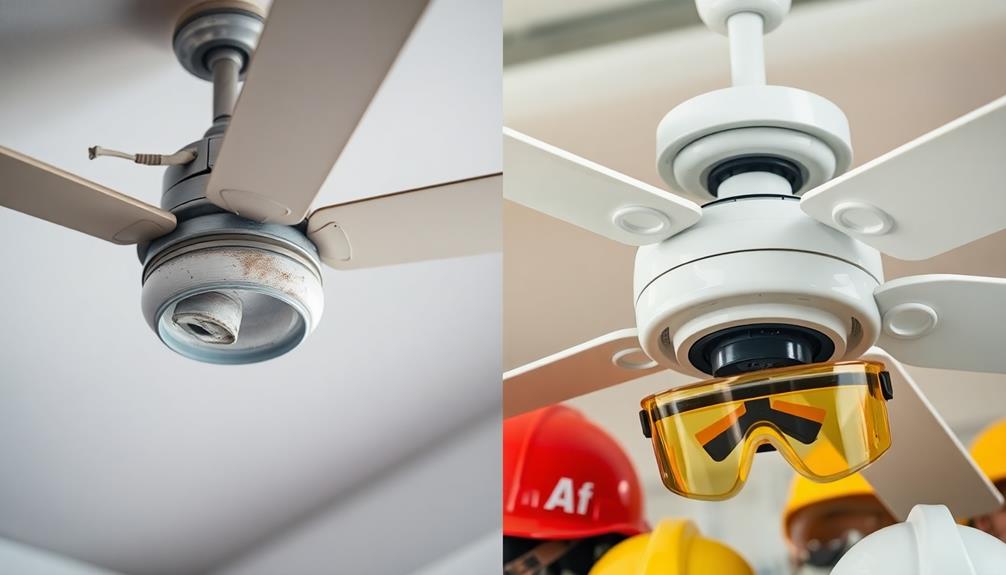Ceiling fans can pose a safety hazard if they are not installed or maintained properly. Issues such as loose mounting, excessive weight, or a lack of regular checks can result in accidents. It is important to ensure that your fan is securely mounted and to regularly inspect it for any signs of wear or damage. Dust accumulation and loose hardware can compromise the stability of the fan, so it is crucial to keep it clean and tighten any screws. Avoid hanging heavy objects from the fan, as this can exceed its weight capacity. Taking a proactive approach to maintenance can improve both safety and performance. If you would like to learn more about how to keep your ceiling fan safe, there is plenty of information to explore.
Key Takeaways
- Improper installation and loose mounting hardware are primary causes of ceiling fan falls, emphasizing the need for secure installation.
- Regular maintenance, like tightening screws and cleaning dust, is crucial for preventing inefficiencies and potential accidents.
- Overloading ceiling fans beyond their weight capacity compromises safety; always consult manufacturer guidelines for weight limits.
- Signs of potential issues, such as unusual noises or wobbling, should be addressed promptly to maintain fan safety and performance.
- Professional installation ensures secure mounting, compliance with safety standards, and can include routine inspections for ongoing safety.
Causes of Ceiling Fan Falls
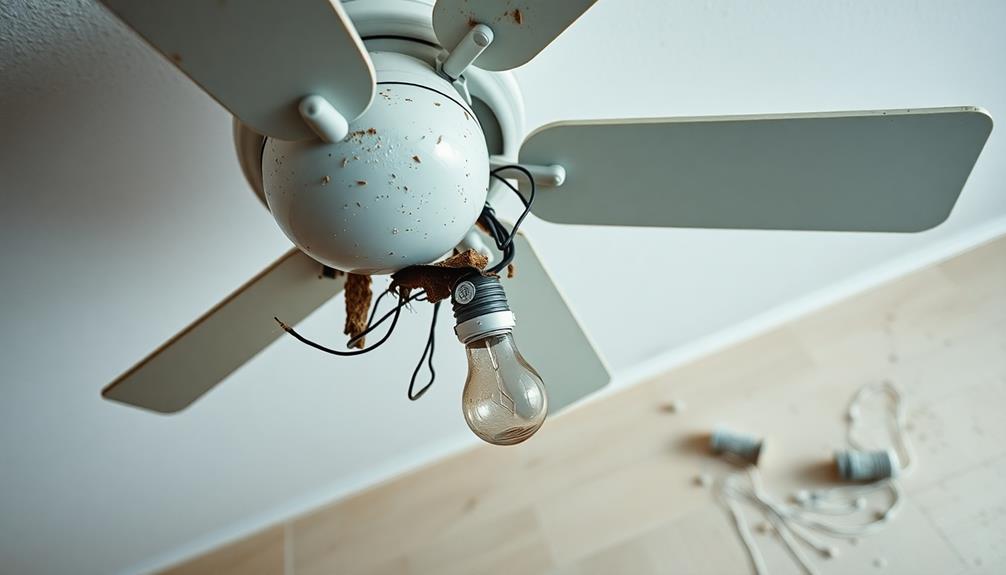
Ceiling fans can pose significant safety risks if not installed or maintained properly. Improper installation is a primary cause of fan falls. If you don't secure the fan correctly, it can loosen over time, increasing the risk of it falling.
Additionally, overloading the fan with excessive weight can strain the motor and lead to overheating. Modern Energy Star certified fans can help alleviate some of these risks by enhancing airflow and reducing reliance on air conditioning, which can lower the risk of overheating increased fan efficiency.
You must also consider the age and wear of the fan; as components degrade, they may fail unexpectedly. Loose or damaged mounting hardware can further compromise stability, especially in humid environments.
Regular checks and proper installation practices are essential to ensuring your ceiling fan remains safely in place and functions efficiently. Don't overlook these factors—they're critical for your safety.
Importance of Maintenance and Inspection
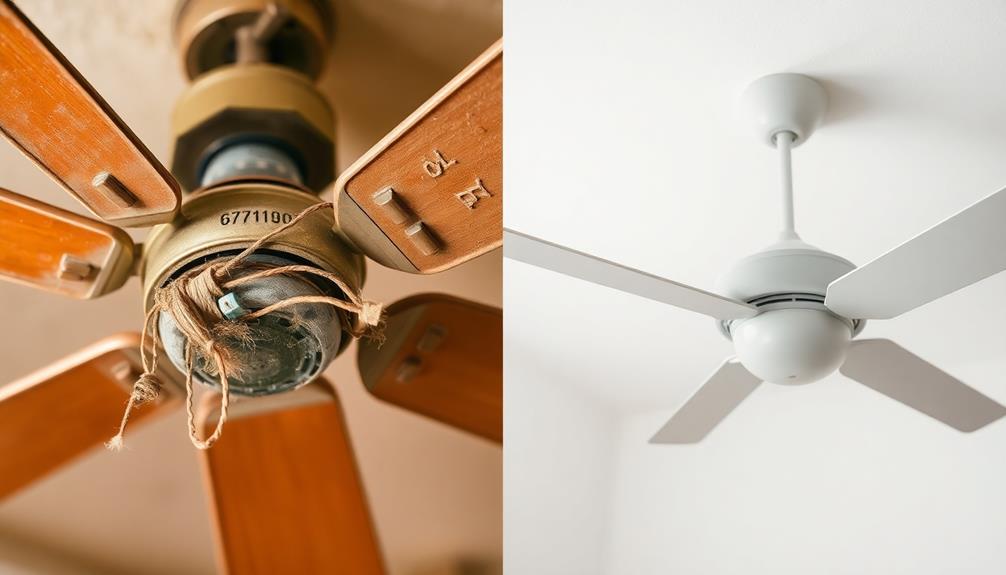
Regular maintenance and inspection are essential for keeping your ceiling fan in safe and efficient working order. Neglecting these tasks can lead to various safety hazards, including falls and electrical issues. By routinely checking your fan, you can catch problems early and guarantee your family's safety.
| Issue | Consequence |
|---|---|
| Dust accumulation | Reduced efficiency and imbalance |
| Loose mounting hardware | Increased risk of fan falls |
| Rust on components | Structural integrity compromised |
| Worn-out motor or blades | Potential failure and overheating |
| Neglected lubrication | Increased friction and operational strain |
Don't wait for a problem to arise; make maintenance and inspection a regular part of your home care routine. Your safety depends on it!
Preventive Safety Tips
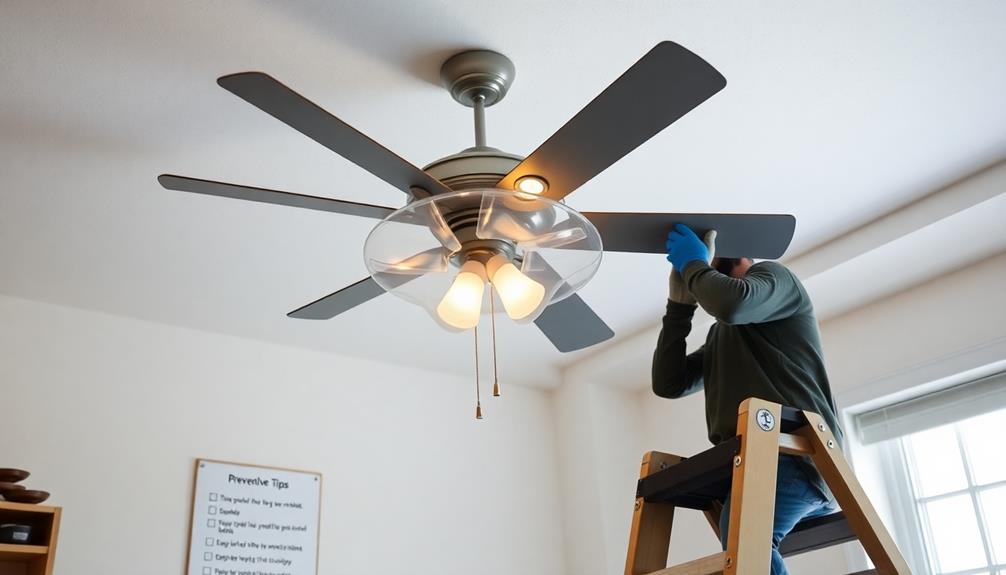
Securing your home is safe means paying attention to preventive safety tips for ceiling fans.
First, install your ceiling fan on a sturdy, reinforced ceiling to avoid accidents. Regularly check and tighten any loose screws or bolts; this simple action can prevent potential falls.
Avoid hanging heavy objects from your ceiling fan, as this can strain the motor and compromise stability. Use appropriate mounting hardware to guarantee a secure installation, following the manufacturer's guidelines. Additionally, ensure that the fan blades are balanced to prevent wobbling during operation, which could reduce the lifespan of your fan. If you wish to incorporate decorations, explore ceiling décor hanging techniques that evenly distribute weight and avoid placing undue stress on your fan. It’s always best to consult with experts or follow trusted resources to ensure safety and proper implementation. If you’re unsure about how to hang ceiling décor without affecting the fan’s performance, it’s essential to seek advice from knowledgeable professionals or DIY experts. They can guide you on the safest methods and materials to use, ensuring that your décor enhances the space without posing risks. Always prioritize safety while making decorative adjustments to any ceiling fixture.
Finally, perform routine maintenance to identify any issues early on, such as unusual noises or vibrations.
Understanding Weight Capacity
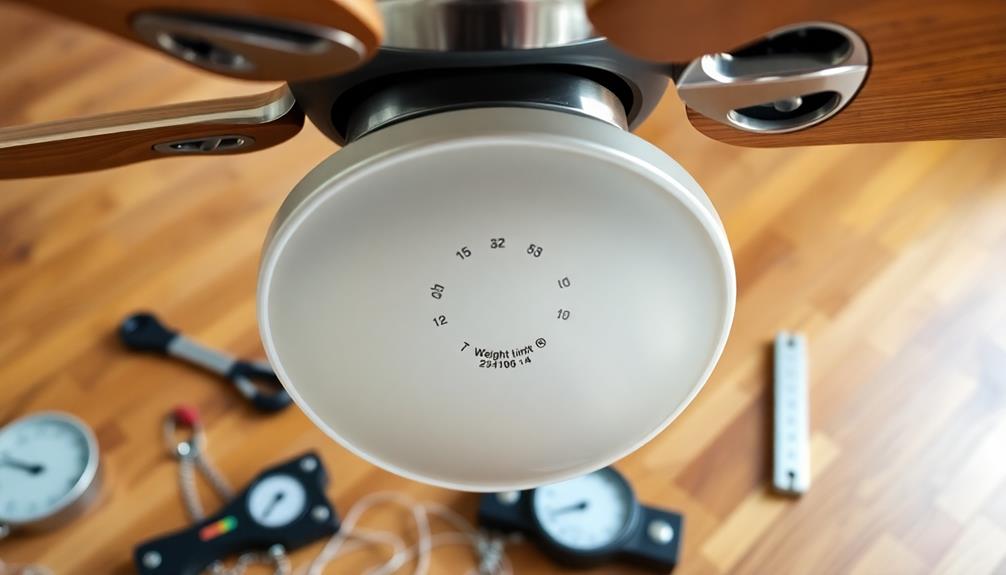
Understanding the weight capacity of your ceiling fan is essential for safe operation. Each fan has a specific weight limit, usually outlined in the manufacturer's specifications, typically ranging from 10 to 50 pounds.
When you install a fan, consider not just its weight, but also any additional attachments, like light kits. Overloading your fan can compromise its stability, leading to potential safety hazards.
If you're unsure about the weight limits, consult the manufacturer's guidelines or a qualified electrician. Always verify that the mounting hardware and ceiling structure can support the combined weight.
Regularly check for signs of wear or loose components, as these can also affect the fan's ability to operate safely within its designated weight capacity.
Special Installation Considerations
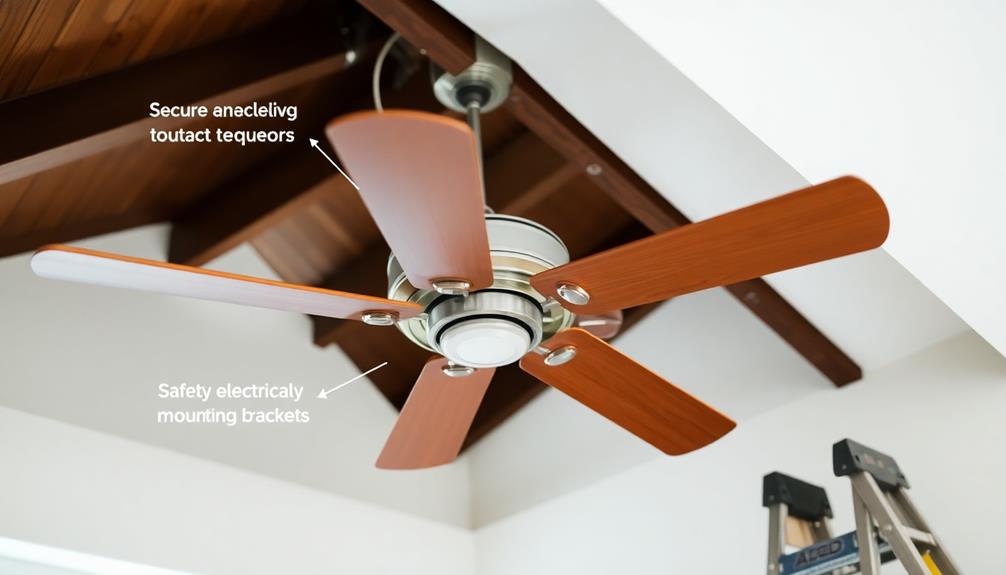
When installing ceiling fans, particularly in low ceilings, you need to take into account several key factors to assure safety and efficiency.
First, choose low-profile fans designed to maximize airflow without compromising headroom. Ascertain the fan's blades are at least 7 feet above the floor to prevent accidents.
Securely mount the fan to a sturdy ceiling joist; inadequate support can lead to instability. Additionally, adhere to local regulations regarding ceiling fan installation, as they may dictate height and electrical requirements.
Avoid adding heavy attachments that exceed the fan's weight capacity, as this can strain the motor and affect performance.
Signs of Potential Issues
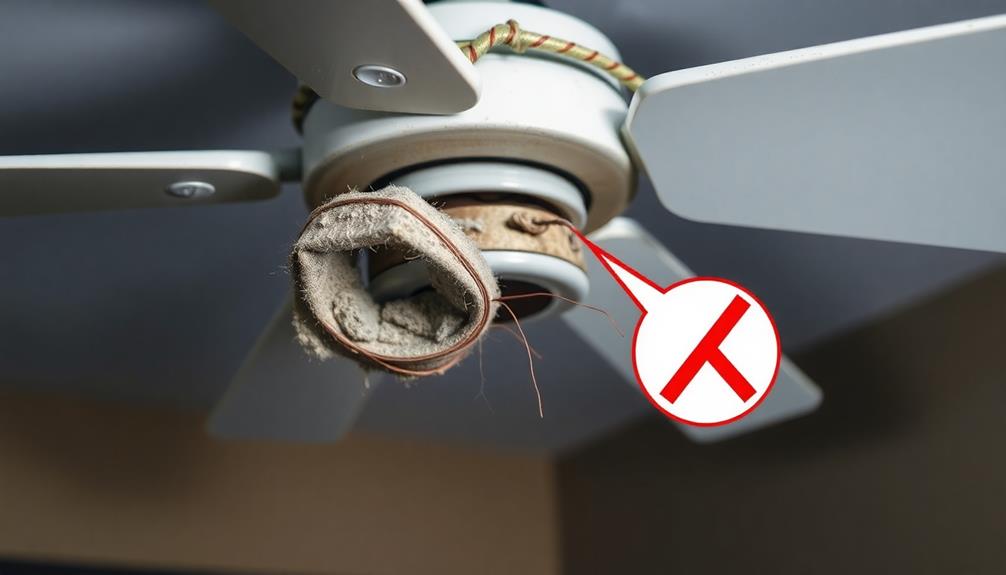
After you've taken the necessary precautions for installing your ceiling fan, it's important to stay vigilant for signs of potential issues that could affect its performance and safety.
Regularly monitoring for these indicators can save you from bigger problems down the line.
Here are three signs to watch for:
- Unusual Noises: If you hear grinding, rattling, or humming, it could indicate loose parts or motor issues.
- Wobbling or Shaking: Excessive movement while the fan operates can signal mounting hardware problems or imbalanced blades.
- Increased Energy Bills: If your energy costs rise unexpectedly, your fan might be struggling due to wear or improper installation.
Address these signs promptly to guarantee your ceiling fan remains safe and effective.
Professional Installation Benefits
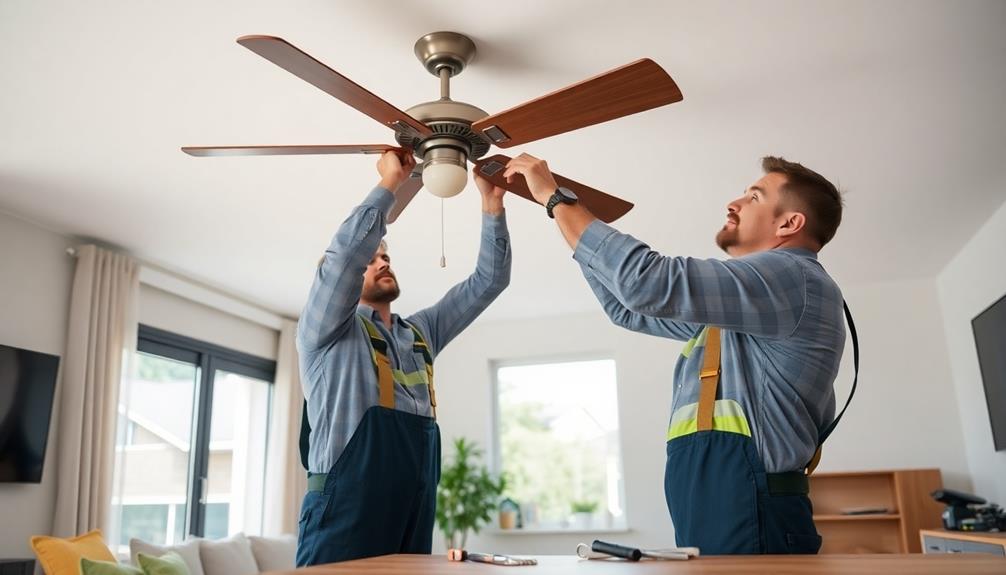
Hiring a professional for ceiling fan installation can considerably reduce the risks associated with improper setup. Experts have the knowledge and experience to guarantee your fan is securely mounted and properly wired, minimizing the chances of it falling or causing electrical issues.
They follow manufacturer guidelines and use the right hardware, which is essential for safety and performance. Additionally, professionals can assess your space to determine the best fan type and location, maximizing airflow and efficiency.
Regular inspections and maintenance can also be scheduled, keeping your fan in top condition. Ultimately, investing in professional installation gives you peace of mind, knowing your ceiling fan is safely installed and functioning correctly.
Frequently Asked Questions
How Can I Tell if My Ceiling Fan Is Installed Correctly?
To guarantee your ceiling fan's installed correctly, check for secure mounting, tight screws, and proper electrical connections. Look for wobbling or unusual noises, and inspect the blades for any signs of damage or imbalance.
What Is the Average Lifespan of a Ceiling Fan?
Ever wondered how long your ceiling fan will last? Generally, you can expect it to operate efficiently for about 10 to 15 years, provided you maintain it well. Regular care makes a difference!
Can Ceiling Fans Cause Allergies Due to Dust Accumulation?
Yes, ceiling fans can contribute to allergies if they accumulate dust. When you run the fan, it circulates allergens. Regular cleaning helps minimize dust buildup, making your space healthier and more comfortable for everyone.
Are There Specific Ceiling Fan Brands Known for Safety?
When it comes to safety, you can't afford to cut corners. Brands like Hunter and Casablanca are renowned for their safety features, ensuring proper installation and durable materials, so you can enjoy peace of mind while staying cool.
How Do I Properly Dispose of an Old Ceiling Fan?
To properly dispose of an old ceiling fan, first disconnect it safely. Then, check local regulations for recycling options. You can also donate it if it's still functional, or take it to a waste facility.
Conclusion
In the grand dance of home comfort, your ceiling fan plays an essential role, but it can also be a potential misstep if not properly cared for. By staying vigilant and proactive with maintenance, inspections, and understanding weight limits, you can guarantee your fan twirls safely overhead. Think of it as tuning a musical instrument—regular care keeps the harmony intact. So, embrace these safety tips and enjoy the cool breeze with peace of mind.
